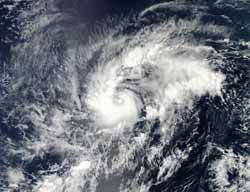NASA Sees Brief Life of Tropical Storm Olivia

On Oct. 6, 2012 at 21:25 UTC 5:25 p.m. EDT, NASA's Aqua satellite captured this true-color image of Tropical Storm Olivia off the western Mexico coast. (Credit: NASA/Goddard/MODIS Rapid Response Team)<br>
On Oct. 6, Tropical depression 15E was born near 14.0 North latitude and 118.7 West longitude, about 845 miles southwest of the southern tip of Baja California. It would later strengthen into Tropical Storm Olivia.
On Oct. 6, 2012, at 21:25 UTC 5:25 p.m. EDT, the Moderate Resolution Imaging Spectroradiometer (MODIS) instrument that flies aboard NASA's Aqua satellite captured a true-color image of Tropical Storm Olivia off the western Mexico coast. Olivia looked promising, with a large band of thunderstorms wrapping into its center of circulation from the north and west, but adverse atmospheric conditions quickly took a toll on the system.
On Oct. 9, 2012, Tropical Storm Olivia ceased to qualify as a tropical cyclone and was designated by the National Hurricane Center as a remnant low pressure area.
At 0900 UTC (5 a.m. EDT), on Oct. 9, Olivia had maximum sustained winds near 35 mph (55 kph). It was centered about 950 miles (1,530 km) west-southwest of the southern tip of Baja California, near 15.2 North and 122.0 West. It was moving to the southwest at 7 mph (11 kph). Olivia's remnants are expected to continue weakening and move southwest then west before dissipating on Wednesday, Oct. 10.
Text credit: Rob Gutro
NASA's Goddard Space Flight Center, Greenbelt, Md.
Media Contact
All latest news from the category: Earth Sciences
Earth Sciences (also referred to as Geosciences), which deals with basic issues surrounding our planet, plays a vital role in the area of energy and raw materials supply.
Earth Sciences comprises subjects such as geology, geography, geological informatics, paleontology, mineralogy, petrography, crystallography, geophysics, geodesy, glaciology, cartography, photogrammetry, meteorology and seismology, early-warning systems, earthquake research and polar research.
Newest articles

Sea slugs inspire highly stretchable biomedical sensor
USC Viterbi School of Engineering researcher Hangbo Zhao presents findings on highly stretchable and customizable microneedles for application in fields including neuroscience, tissue engineering, and wearable bioelectronics. The revolution in…

Twisting and binding matter waves with photons in a cavity
Precisely measuring the energy states of individual atoms has been a historical challenge for physicists due to atomic recoil. When an atom interacts with a photon, the atom “recoils” in…

Nanotubes, nanoparticles, and antibodies detect tiny amounts of fentanyl
New sensor is six orders of magnitude more sensitive than the next best thing. A research team at Pitt led by Alexander Star, a chemistry professor in the Kenneth P. Dietrich…





















